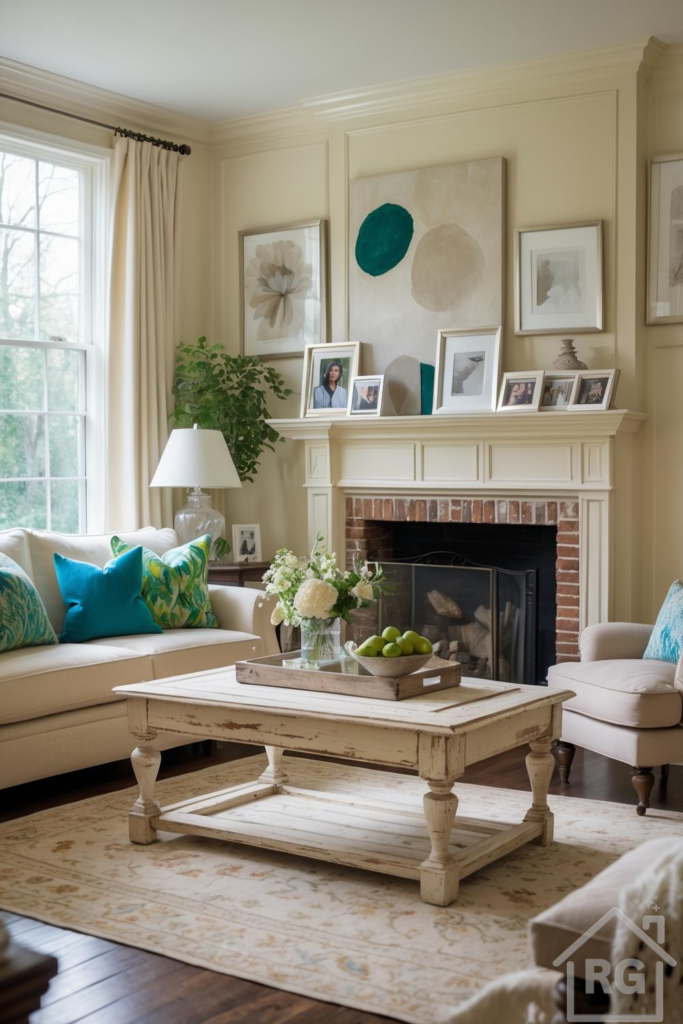
Step into a world where classic elegance meets inviting comfort – the Colonial living room. This enduring design aesthetic, rooted in historical charm and a deep appreciation for natural beauty, offers a sanctuary of warmth and sophistication. Far from being staid or overly formal, a well-executed Colonial living space, like the one pictured, breathes with a serene vitality, blending traditional elements with refreshing touches that make it feel utterly current and deeply personal. If you dream of a home that whispers tales of timeless grace while embracing you in a cozy embrace, then the Colonial style is your perfect muse.
The Essence of Colonial Charm: A Harmonious Blend
At its heart, Colonial design is about creating a space that feels lived-in, loved, and naturally beautiful. It’s a style that values craftsmanship, comfort, and a connection to the natural world. The room we see exemplifies this beautifully, showcasing how a thoughtful curation of colors, textures, and furnishings can result in an atmosphere that is both grand and genuinely welcoming.
A Palette of Serenity and Subtle Vibrancy
The foundation of this Colonial living room’s allure lies in its masterful use of color. The walls, painted in a soft, creamy beige, provide a warm and expansive backdrop, allowing natural light to diffuse gently throughout the space. This neutral base is echoed in the plush, off-white upholstery of the sofa and armchairs, creating a sense of continuity and calm. These foundational hues are anything but boring; they are the quiet anchors that allow carefully chosen accent colors to truly sing.
Notice the delightful pops of color introduced through the throw pillows: a rich, deep teal and a lively, verdant green. These shades, reminiscent of tranquil waters and lush foliage, inject a refreshing energy into the room without overwhelming its serene character. The abstract art above the mantel subtly incorporates these greens and teals, tying the entire color story together. Even the fresh green apples in the decorative bowl on the coffee table echo this natural vibrancy, demonstrating how even small details contribute to the overall color harmony. This approach to color – a generous neutral base punctuated by thoughtful, nature-inspired accents – is a hallmark of successful Colonial design, ensuring the space feels both sophisticated and alive.
Textures That Tell a Story: A Tactile Feast
Beyond color, the Colonial living room excels in its rich tapestry of textures, each element contributing to the room’s inviting depth. The dark, polished hardwood floors provide a grounding contrast to the lighter elements, their natural grain adding an organic warmth underfoot. Layered upon this is a beautiful area rug in a light, muted pattern, its soft fibers inviting bare feet and defining the central seating area with a gentle embrace. This interplay of hard and soft surfaces is crucial for creating a dynamic yet comfortable environment.
The star of the show, the distressed white coffee table, is a testament to the beauty of aged character. Its chipped paint and visible wood grain tell a story, adding a touch of rustic charm and authenticity that perfectly complements the room’s refined air. This piece, with its sturdy turned legs, grounds the space and provides a focal point. The plush upholstery of the sofa and armchairs, likely a durable linen or cotton blend, invites you to sink in, promising comfort and relaxation. The crisp, flowing linen curtains at the large window soften the incoming light, adding a delicate texture that billows gently with the breeze. Even the rough texture of the brick fireplace, juxtaposed with the smooth, painted wood mantel, adds a layer of visual and tactile interest, reinforcing the room’s classic, enduring appeal.
Furnishings: Classic Forms, Enduring Comfort
The furniture in this Colonial living room is chosen for both its classic form and its inherent comfort. The generous sofa, with its clean lines and deep cushions, is clearly designed for lounging and conversation. Paired with a comfortable armchair, it creates an intimate seating arrangement around the central coffee table. These pieces are not overly ornate but possess a quiet dignity, reflecting the Colonial preference for practical elegance.
The distressed coffee table, as mentioned, is a standout piece, its substantial presence anchoring the room. A small side table next to the sofa provides a convenient spot for a lamp and a drink, emphasizing functionality. The overall arrangement promotes ease of movement and encourages gathering, making the room feel genuinely hospitable.
The Heart of the Home: The Fireplace and Its Mantel
In many Colonial homes, the fireplace served as the literal and figurative heart of the living space, providing warmth and a natural gathering point. Here, the brick fireplace, with its classic white wooden mantel, continues this tradition. It’s not just a functional element but a beautifully styled focal point. The mantelpiece is adorned with a curated collection of framed photographs and elegant wall art, creating a personal gallery that adds character and tells a story. The large abstract painting above the mantel, with its organic shapes and subtle colors, adds a contemporary touch that prevents the room from feeling too traditional, demonstrating a thoughtful blend of old and new.
Thoughtful Details: The Art of Accessorizing
It’s often the small details that elevate a room from merely furnished to truly designed. In this Colonial living room, accessories are chosen with care to enhance the overall aesthetic without cluttering the space. A beautiful glass table lamp on the side table provides soft, ambient lighting, its classic silhouette fitting seamlessly into the decor. Fresh flowers, artfully arranged in a clear vase on the coffee table, bring life and a touch of natural elegance, their delicate petals a beautiful contrast to the sturdy wood. A lush green plant tucked behind the sofa adds another layer of organic texture and a burst of natural color, improving air quality and bringing the outdoors in.
The collection of framed photographs on the mantelpiece adds a deeply personal touch, transforming the house into a home. These elements, though seemingly minor, are crucial for creating a space that feels inviting, lived-in, and uniquely yours.
Achieving Your Own Colonial Sanctuary: Practical Tips
- Embrace a Neutral Foundation: Start with warm, inviting neutrals like creamy whites, soft beiges, and gentle grays for your walls and larger furniture pieces. These colors create a serene backdrop and allow your accent pieces to shine.
- Introduce Nature-Inspired Accents: Bring in pops of color through throw pillows, artwork, and decorative objects. Think deep teals, forest greens, muted blues, or even soft terracotta. These colors should feel organic and harmonious with your neutral base.
- Layer Textures Generously: Don’t shy away from mixing materials. Combine the richness of dark hardwood floors with soft area rugs. Incorporate the rustic charm of distressed wood furniture with the plushness of upholstered pieces. Add natural fibers like linen, cotton, and wool through curtains, throws, and pillows. This layering adds depth and visual interest.
- Prioritize Comfort and Functionality: Colonial design values practicality. Choose comfortable, well-proportioned furniture that invites relaxation. Ensure there are convenient surfaces for drinks and lamps. A well-designed Colonial room is meant to be lived in.
- Highlight Architectural Features: If you have a fireplace, make it a focal point. Enhance it with a classic mantel and decorate it with personal touches. Crown molding, wainscoting, or large windows are also opportunities to showcase traditional architectural beauty.
- Curate Personal Touches: Display framed family photos, cherished heirlooms, or meaningful artwork. These personal elements are what truly make a house a home and add a layer of authenticity to the Colonial aesthetic.
- Bring the Outdoors In: Incorporate fresh flowers, potted plants, and natural elements like decorative bowls of fruit or branches. This connects your interior space to the natural world, a key aspect of Colonial living.
- Balance Old and New: While Colonial style is traditional, it doesn’t mean everything has to be antique. As seen in the example, a modern abstract painting can beautifully complement classic furniture, adding a fresh perspective and preventing the room from feeling dated.
- Consider Lighting: Maximize natural light with unencumbered windows and light-colored curtains. Supplement with ambient lighting from table lamps and floor lamps to create a warm glow in the evenings.
A Legacy of Comfort and Style
The Colonial living room is more than just a design trend; it’s a philosophy of living that celebrates comfort, enduring beauty, and a connection to history. By thoughtfully combining a serene color palette, rich textures, classic furnishings, and personal touches, you can create a living space that feels both grand and intimately inviting. It’s a room where memories are made, conversations flow easily, and every moment is steeped in a quiet, timeless elegance. Embrace the charm, and let your home tell its own beautiful story.
